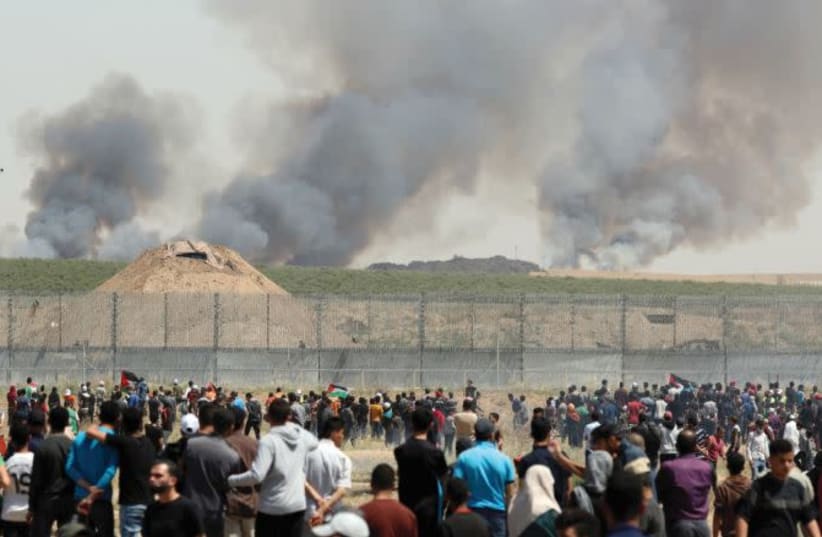Paka paka pak pak pak… Is that the sound of gunfire? This was the first day of the “ceasefire” after the unprovoked rocket fire and attacks by Islamic Jihad and Hamas from Gaza that had killed and injured innocent civilians over the span of a few days of terror in Israel. However, there is no ceasing of the insanity at the Gaza border. The sound we hear is that of the would-be invaders and murderers being kept at bay by Israeli troops firing into the sand.
My friend Pesach Nisenbaum suggested that we need to do something for the children of what the “Red Alert” app on our phones refer to as the “Gaza Envelope.” We let our friends in our community know that we were going to buy some pizza for children in the Sderot area and, in one day, we had over NIS 4,000 for “pizza money.” We were joined by two other friends, Shalom Zeidel and Marvin Shechter in Pesach’s car for a road trip to the Gaza border, which is not far from our community in Jerusalem. However, the “Gaza Envelope” communities are a world away from our normal lives as Jerusalemites.
Ohad, on the outskirts of Sderot, our supplier for love in pizza form, churned out 60 pizza pies. We went to a regional school in Kibbutz Saad and the IDF base at Nahal Oz, with pizza and not much else by way of a plan. We had taken a day to bring pizza and some shekels, but what we got in return was priceless.
The younger children were in school for the first time since they began sleeping in or close to their bomb shelter. At the army base, the older “children” were still on vigilant engagement, keeping our country safe. These are all our children. Yet, when we sit in our homes north of the “Gaza Envelope,” we keep their situation at a distinct distance. Not in actual space/time, but in emotional disconnect. We saw the constant alerts and perhaps fumed at the reports from the media, but that was divorced from the reality.
SOLDIERS, SCHOOLCHILDREN and teachers alike expressed the same sentiment. They were surprised that we made the “journey” from Jerusalem just to be with them. You can sense the hope that we can all be with them – always. Somehow it seemed they were not so sure that this is the case.
On display are monuments to victims of past attacks, from the fedayeen of decades ago to the modern-day terrorism from Hamas and their affiliates. We saw signs of the resilience of our fellow citizens in the urban center of Sderot. At the hesder yeshiva, there is the now-famous menorah sculpture made from rocket parts that had been shot at them, and other such art created from terror. At a kindergarten, we saw an outrage from the past few days. A rocket had landed in the playground, taking down a shelter and forming a crater. The shrapnel raked the kindergarten walls, pillars and ceiling, and damaged several surrounding buildings. An air conditioning apparatus was torn off of one building. Glass had been shattered and walls pockmarked. One could only imagine the horror of just one such shrapnel piece meeting up with flesh and bone.
As we stood on the border and looked across the field at the Gaza Strip, we saw the Palestinian flag fluttering. There were no longer any Israeli communities on the other side of the field. There is not one single Israeli soldier on the far side of that field. However, the gunfire continues incessantly. The threat of rockets and missiles and mortars again hitting cars, buses, homes, kindergartens and their precious humanity within is omnipresent. The folks on the other side of the field are being encouraged to invade the side that is Israel. Gaza’s population, held captive by Hamas, is given some sort of hope that death and violence will somehow open vistas for them to a better life via an impossible objective.
We can make life in these communities a bit better by making the bridge between the center of the country and the so-called Gaza Envelope communities into a vast multi-lane one flowing with constant interaction. That is on the Israel side of the field. Unfortunately, the long-term answer is only to be found on the other side of the field.
Until then, it is the paka pak pak of gunfire – and making sure that everyone, at any time of day or night, can get to shelter… in 15 seconds.
The writer has served in several capacities in building Israel-US trade relations, including that of director of trade/trade commissioner for the Government of Israel to the United States. He now lives in Jerusalem.
